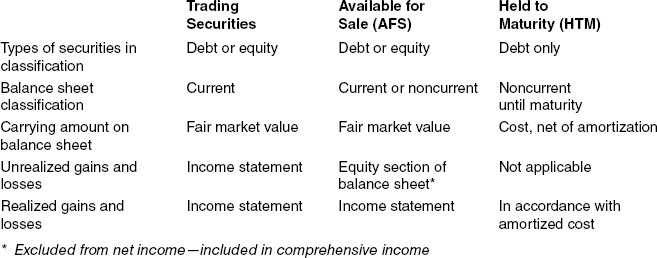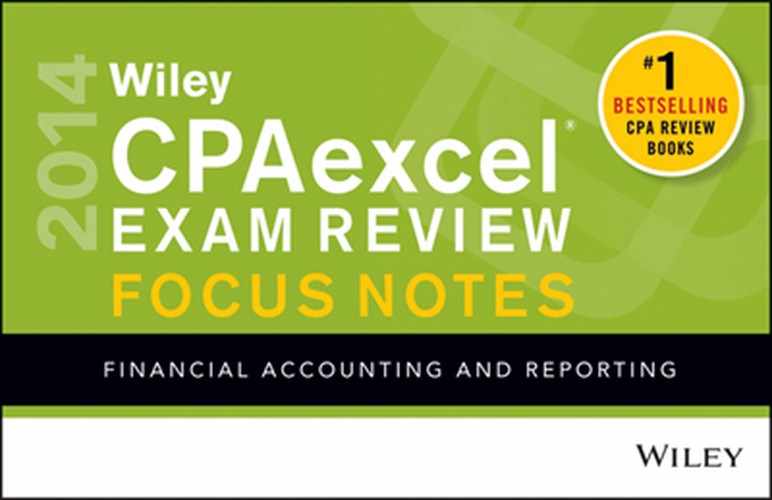Focus on: Investments—Module 16
METHODS OF REPORTING INVESTMENTS
| Method | Conditions |
| Consolidation | Majority owned (> 50%) |
| Equity | Less than majority owned |
| Ability to exercise significant influence | |
| Ownership generally ≥ 20% | |
| Cost | Less than majority owned |
| Unable to exercise significant influence | |
| Ownership generally < 20% | |
| Not an investment in marketable securities | |
| Special Rules | Less than majority owned |
| (ASC 320/FASB #115) | Unable to exercise significant influence |
| Ownership generally < 20% | |
| Investment in marketable securities |
Equity Method
Carrying Value of Investment
Cost
+ Earnings
– Dividends
= Carrying value of investment
Earnings
Income reported by investee
× % of ownership
= Unadjusted amount
– Adjustments
= Investor’s share of investee’s earnings
Adjustments to Earnings
1. Compare initial investment to FMV of underlying net assets
2. Portion of excess may be due to inventory
Deduct from income in the first year (unless inventory not sold during year)
3. Portion of excess may be due to depreciable asset
Divide by useful life and deduct from income each year
4. Portion of excess may be due to land
No adjustment (unless land sold during year)
5. Remainder of excess attributed to goodwill
Test each year for impairment and deduct from income if it has occurred
Application of Equity Method
Information given:
| Investment | 25% |
| Cost | $400,000 |
| Book value of investee’s underlying net assets | $900,000 |
| Undervalued assets: | |
Inventory |
100,000 |
Building (20 years) |
400,000 |
Land |
200,000 |
| Investee’s unadjusted income | $225,000 |
| Dividends | $40,000 |
Information Applied

Changes to and from the Equity Method
Equity Method to Cost Method
- No longer able to exercise significant influence
- Usually associated with sale of portion of investment
- Apply equity method to date of change
- Apply cost method from date of change
Cost Method to Equity Method
- Now able to exercise significant influence
- Usually associated with additional purchase
- Apply equity method retroactively
- Affects retained earnings and investment for prior periods
Fair Value Option
- An entity may elect to value its securities at fair value.
- If elected, available-for-sale, held-to-maturity, or equity method investments securities MTM and gain/loss goes to income
Marketable Securities (MES)

Transferring MES between Categories
When transferring between categories (e.g., trading to AFS), the transfer is
1. Accounted for at fair value
2. Unrealized holding gains/losses are adjusted so as not to be double counted
IFRS Investments
Similar to U.S. GAAP, IFRS classifies securities in categories but the account titles differ.
Held for trading (HFT)—further classified as a fair value through profit or loss (FVTPL) security.
- FVTPL securities are remeasured each accounting period.
- Available for sale (AFS)
- Held to maturity (HTM)
- Equity method investments (can use the equity method or FVTPL)
- Can elect to use the FVTPL method for AFS or HTM securities providing the security has an active market.
- Once the election is made, it may not be changed.
Instruments without quoted market prices should be accounted for using the cost method.
Life Insurance
Payment of premium:
| Cash surrender value of life insurance (increase in value) | xxx | |
| Insurance expense (plug) | xxx | |
Cash (premium amount) |
xxx |
Death of insured:
| Cash (face of policy) | xxx | |
Cash surrender value of life insurance (balance) |
xxx | |
Gain (difference) |
xxx |
..................Content has been hidden....................
You can't read the all page of ebook, please click here login for view all page.
